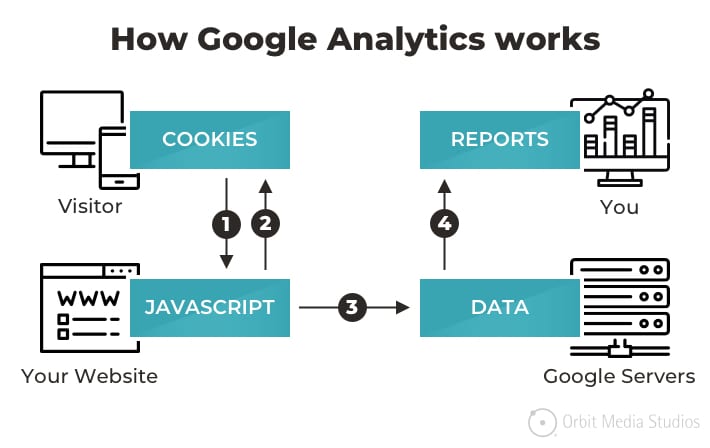Master Internet Site Insights With Accurate Google Analytics Monitoring Code
The reliable application of Google Analytics rests on the specific execution of its tracking code, a fundamental action often neglected by website proprietors. This apparently basic JavaScript bit, when properly placed, comes to be the foundation of data collection, offering insights right into individual habits and website efficiency. Nevertheless, challenges can arise throughout configuration, potentially skewing the information and resulting in mistaken decisions. Understanding these details is necessary for making the most of the benefits of analytics. What are the typical pitfalls that could threaten your tracking initiatives, and how can you make certain accuracy in your strategy?
Comprehending Google Analytics Essentials
Google Analytics is a necessary tool for web site proprietors and online marketers, giving vital understandings into individual actions and site efficiency. At its core, Google Analytics accumulates data about visitors to a web site, permitting users to examine metrics such as traffic sources, individual involvement, and conversion rates. Understanding these basics is critical for optimizing a site's efficiency and boosting user experience.
The platform employs cookies to track interactions, taping information such as web page sights, session periods, and bounce prices. This details is accumulated and offered through customizable control panels, allowing users to envision trends in time. Trick performance indicators (KPIs) can be kept track of, such as the total number of individuals, new versus returning visitors, and the geographic circulation of the target market.
In Addition, Google Analytics supplies division functions, enabling individuals to isolate particular traffic sources or user demographics for even more targeted evaluation. By grasping these foundational elements, website proprietors can make enlightened choices about material technique, marketing campaigns, and total website enhancements. Ultimately, understanding Google Analytics basics is essential for leveraging information to drive development and accomplish business purposes successfully.
Setting Up Your Tracking Code

Copy the offered monitoring code and paste it right into the HTML of your website. This makes sure that the tracking code loads prior to any other web content, enabling it to record information precisely.
After installation, validate that the tracking code is operating appropriately by utilizing Google Tag Assistant or the Real-Time reports in Google Analytics - when does the google analytics tracking code send an event hit to analytics?. This step is necessary to validate that your data collection is energetic and exact, establishing the foundation for insightful analysis
Common Tracking Code Issues
This might happen when the tracking code is placed in the wrong section of the web site's HTML, frequently leading to insufficient or absent data. In addition, having numerous circumstances of the tracking code on a solitary web page can result in inflated metrics, as customer interactions could be counted extra than as soon as.
One more concern emerges from making use of advertisement blockers, which can stop the tracking code from carrying out entirely, hence skewing data. when does the google analytics tracking code send an event hit to analytics?. Furthermore, failure to configure filters properly can result in the exemption of crucial website traffic sources or the inclusion of unwanted reference spam, distorting the information collected
Site owners may likewise ignore the importance of monitoring code updates, particularly when moving to Google Analytics 4 (GA4) from Universal Analytics. Finally, inadequate screening prior to releasing changes can lead to unnoticed errors in the tracking code, better complicating information reliability. Attending to these common issues is critical for making sure precise tracking and informative analytics.
Studying Internet Site Information Successfully
Precise data collection is only the primary step in leveraging Google Analytics; the genuine worth lies in efficiently analyzing that data to drive enlightened decision-making. To attain this, it is important to identify key efficiency signs (KPIs) that align with your company objectives. Focus on metrics such as conversion prices, user engagement, and website traffic great post to read resources, as these will certainly supply understandings into customer behavior and the total performance of your internet site.
Using Google Analytics' segmentation features permits a deeper understanding of your audience. By breaking down data into particular demographics, habits, and traffic networks, you can discover patterns and patterns that inform targeted strategies. Carrying out customized records and control panels can enhance this procedure, enabling quick access to relevant data.
Furthermore, routinely assessing information fads gradually aids to identify abnormalities and opportunities for renovation. Use visualization tools to present data in a quickly absorbable layout, promoting much more reliable interaction with stakeholders. Ultimately, the ability to analyze site information properly empowers companies to make calculated choices that enhance customer experience, maximize advertising and marketing initiatives, and drive development.

Best Practices for Accurate Monitoring
Carrying out effective tracking methods is critical for getting reputable data in Google Analytics. To make sure accurate monitoring, start by properly mounting the Google Analytics tracking code on every page of your internet site. This can be accomplished through a tag supervisor or by directly installing the code into the HTML.
Next, configure your Google Analytics account to omit interior website traffic. This can be done by establishing filters that identify and get rid of brows through from your organization's IP address, thus stopping manipulated information. Additionally, utilize event tracking to check specific user interactions, such as downloads or video plays, which common web page sights might overlook.
Frequently investigate your tracking configuration to verify that all functions, such as goals and ecommerce tracking, are working properly. Develop a consistent naming convention for your campaigns and events to help with much easier coverage and evaluation.
Finally, think about leveraging UTM specifications for campaigns to acquire insights right into the efficiency of various advertising efforts. By complying with these best practices, you can boost the precision of your information collection and analysis, ultimately leading to even more educated decision-making for your web site.
Conclusion
By guaranteeing the monitoring code is properly positioned and regularly investigated, website owners can record crucial user interaction information, hence assisting in the identification of crucial efficiency signs. Ultimately, a site durable monitoring framework boosts the capability to drive engagement and enhance total website performance.

Not enough testing prior to releasing changes can result in undetected errors in the monitoring code, even more making complex information dependability.Applying efficient monitoring techniques is vital for getting reliable information in Google Analytics. By guaranteeing the tracking code is correctly put and consistently audited, site proprietors can catch important individual communication information, thus promoting the recognition of crucial performance signs.
 Rider Strong Then & Now!
Rider Strong Then & Now! Alfonso Ribeiro Then & Now!
Alfonso Ribeiro Then & Now! Romeo Miller Then & Now!
Romeo Miller Then & Now! Macaulay Culkin Then & Now!
Macaulay Culkin Then & Now! Naomi Grossman Then & Now!
Naomi Grossman Then & Now!